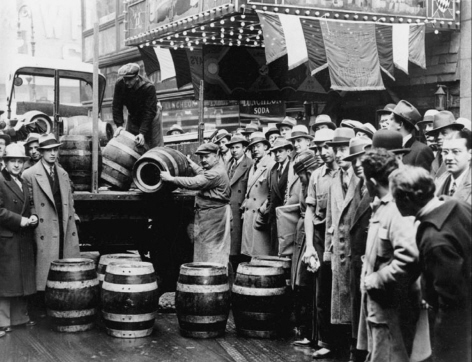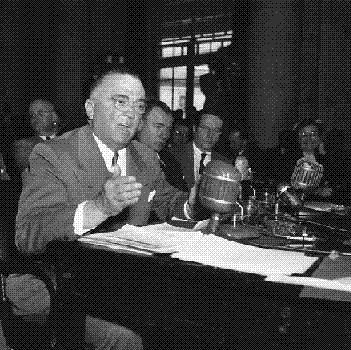The Everything Mafia Book (9 page)


Jack McGurn, whose real name was Vincenzo Gebardi, became known as one of the most feared gangsters in Chicago. Though not a major threat to the new leadership of the Chicago mob, McGurn was killed almost seven years to the day after the Valentine’s Day Massacre.
Capone was out of town, and McGurn had checked into a hotel across town with his girlfriend, so he had witnesses who could place him at the hotel and not at the scene of the crime. Everyone knew who ordered the hit but no one could prove it. The murders captured the fascination of the nation and have become one of the most recognizable events in crime history.
Hoover Takes Notice
In addition to the sensational media attention, the powers-that-be in Washington began to take a closer look at the shenanigans taking place in Chicago. President Herbert Hoover announced that he wanted to see Capone behind bars. He got the U.S. Treasury to set up a task force to go after the crime boss. Though Capone was the master of a multimillion-dollar empire of vice, graft, and murder, he was taken down by the innocuous-sounding charge of tax evasion. But this seemingly small charge was big trouble for Al. He was convicted and sentenced to eleven years in prison.
The Last Years
Capone was first sent to a federal prison in Atlanta, where he lived in relative comfort and used his influence to enjoy special privileges. Unfortunately for Al, he was transferred to the infamous island prison of Alcatraz. Here Capone enjoyed no creature comforts. On Alcatraz he was just another number. He had minimal contact with the outside. All letters were censored, and he was not allowed to read the daily newspapers.
NYC Prohibition is replealed

Courtesy of AP Images
 A crowd gathers as kegs of beer are unloaded in front of a restaurant on Broadway in New York City, the morning of April 7, 1933, when low-alcohol beer is legalized again.
A crowd gathers as kegs of beer are unloaded in front of a restaurant on Broadway in New York City, the morning of April 7, 1933, when low-alcohol beer is legalized again.
Capone’s health deteriorated during his prison stretch. The syphilis he had contracted in his youth grew progressively worse. He only served six and a half years of his sentence. He retired to his Florida estate and continued a slow but steady mental and physical decline until his death in 1947.
Capone’s Successors
The city of Chicago was too rich in racket revenue for the mob to simply give up after Capone’s conviction on tax evasion. He had left a sizable territory for gambling, vice, corruption, and murder. The Chicago Outfit’s empire extended across Illinois into Wisconsin and Indiana, not to mention the pull they exerted over Milwaukee, St. Louis, Kansas City, and Rockford. After he died in 1947, the Chicago mob, or the Outfit, was already becoming a more streamlined, efficient moneymaking machine, one that would rule Chicago through to the twenty-first century.
Nitti
Capone’s right-hand man Frank Nitti was the obvious successor. With his underboss Paul “the Waiter” Ricca and a cohort of Italian, Irish, Polish, and even Welsh gangsters under his command, Nitti expanded the Outfit’s lucrative rackets all the way out to Hollywood, where the Chicago boys were shaking down movie studios and infiltrating the labor unions. Nitti ran into some trouble with the cops, and he was not well respected by his underlings. When the movie studio extortion ring was indicted, Nitti decided to make a grand exit. He shot himself on the railroad tracks; he was one of the few bosses to take his own life.
The Big Tuna
Tony “Big Tuna”/“Joe Batters” Accardo was a Capone henchman whose uncanny intellect and cagey ability to evade law enforcement put him in a good position to lead the Outfit in the post-Capone era. While Paul Ricca took over after Nitti’s death, Accardo became boss, and though he only officially served for a few years, he was considered by many to be the actual boss behind the scenes, putting figurehead bosses (most notably Sam Giancana) out front to take the heat from the feds. The Big Tuna retired to Palm Springs in his later years. When he died in 1992 at the ripe old age of eighty-six, he outlasted most of his mob cohorts, and spent little time in jail.

Mob hit man Frank Calabrese obviously had some serious family issues. When he went to trial in 2007 for racketeering and murder, his own brother and son both testified against the aging South Side crime figure. Cala-brese kept a big smile on his face throughout the testimony. But in the end his brother and son got the last laugh when Frank was found guilty.
Family Secrets
The Outfit expanded its hold not only over the Chicagoland area, but down into Indiana, west to Rockford, north into Wisconsin, and way out west to San Diego. They skimmed cash from casinos in Vegas and stole millions from union pension funds. And although the Tommy-gun happy days of the 1920s were over, the Outfit still used murder as a way to keep the troops in line.
In 2005 the feds announced the biggest indictment ever against the Outfit’s bigwigs. Dubbed Operation Family Secrets, the parade of senior citizen mobsters was the culmination of decades of law enforcement activities. They were charged with a host of murders and criminal acts dating back over thirty years. Some of the names like Joey “The Clown” Lombardo were familiar to mob watchers. Then there were guys like Frank Calabrese. Frank grew up on the South Side of Chicago, along with many of the Outfit’s other soldiers. Calabrese became known as a hit man, loanshark, and all around tough guy. In the end, Calabrese, Lombardo, and the current reputed head of the Chicag Outfit, Jimmy Marcello, were all found guilty. But despite the outcome of the Family Secrets trial there are plenty of Windy City mobsters waiting in the wings to continue Scarface Al Capone’s legacy.
CHAPTER 5
The Real Untouchables
The Mafia felt they were above the law in part because corruption of local police and judiciary were one way the gangsters were able to keep their operations running smoothly. In some cities public corruption became so rampant that the police and public officials were actually part of the mob’s illegal enterprises. But public outcry at a local level eventually worked its way up the line. There was no shortage of crime fighters eager to put a stop to the illegal activities that were going on. In this chapter you will learn about some of the famous crime busters who battled the Mafia.
Federal Case
We have all heard the expression “Don’t make a federal case out of it.” This originated in Al Capone’s Chicago. The Mafia did not want to tangle with the federal government. It shined too much light on them, and the power of federal law enforcement was formidable. Local cops were more easily bribed and intimidated.
Capone’s growing celebrity status and his increasing willingness to revel in the attention put the spotlight on his organization and activities. But the FBI was still a fledgling organization and the Mafia was not yet under their radar.
In Capone’s case, the orders came from Washington to get Scarface. Federal agents formed teams to try and take down the seemingly untouchable mob boss. Television and the movies later made Eliot Ness and his story part of the fabric of American folklore.

Eliot Ness’s post-Treasury career failed to live up to his expectations and he spiraled into alcoholism. Eliot Ness died before his memoir The Untouchables was sold to television and became a hit series starring Robert Stack. Kevin Costner played Ness in the award-winning 1987 feature film that costarred Sean Connery and Robert De Niro.
Ness assembled a handpicked team of agents. He wanted his agents to be under thirty and unmarried. It was a dangerous business, and he did not want to be a widow-maker. After extensive interviews, he settled on nine men. For the record, the real “Untouchables” were Marty Lahart, Sam Sea-ger, Barney Cloonan, Lyle Chapman, Tom Friel, Joe Leeson, Paul Robsky, Mike King, and Bill Gardner.
The Taxman Cometh
It may seem like a strange strategy to prosecute a murderer for not paying his taxes. Capone was always able to slip out of any murder indictment against him. Taxation was another matter altogether. Compliance and/or noncompliance with tax laws is kept on record. Back then gangsters didn’t think enough to make sure all their flaunted ill-gotten gains were kept on record. In later years they came up with creative ways, including no-show jobs on construction sites, and nonexistent sales positions. But Capone did not have any backup documentation for his extravagant lifestyle.
Elmer Irey
Most people have heard of Eliot Ness, but fewer folks probably know the name of Elmer Irey. While Ness went to Chicago to try to nail Capone on Prohibition violations, it was Irey who did the paper shuffling and bean counting to catch Capone on income tax fraud. Ness had recruited a team of intrepid fellow agents who could not be intimidated or bribed. They could not be swayed or stopped by the seductive nature of sin or the potential violence against them.

